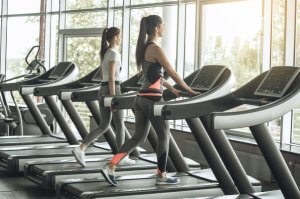Cardio Training: HIIT vs LISS

Cardio training is one of the most effective ways to maintain your body’s general health. It also keeps you in optimal condition. For this reason, many people use this type of training to lose weight.
Although, it’s important to emphasize that there are two types of cardiovascular training. You should choose one according to the objectives that you want to achieve.
Cardio training: what is it and what are its advantages?
Cardiovascular training integrates all of the exercises where the oxygenation process is put to work, more than strength itself. Generally, cardio includes low or medium intensity exercises. These are walking, running, swimming, using an elliptical machine, dancing, Zumba, aerobics, and many more.
This type of training is associated with weight loss. However, you must always remember that without a good meal plan, it won’t be possible to achieve the results you desire.
Besides the benefits that weight loss offers, cardio training also has other advantages for your overall health. For instance, doing cardio for 30 minutes every day or at least three times a week will reduce stress and improve sleep.
Likewise, cardio training is also beneficial for strengthening the heart, reducing the risks associated with high blood pressure, and improving lung capacity.
What are HIIT and LISS?
HIIT and LISS are two types of cardiovascular workouts. It’s important that people learn more about both so that they’re able to select the one that best suits their needs.

HIIT is a type of high-intensity workout where the intervals of the exercises are of short duration. This type of activity lasts an average of 20 minutes and it combines exercises that require a high level of effort and intensity.
On the other hand, LISS consists of low-intensity cardiovascular exercises with longer timespans. These exercises last between 40 and 60 minutes and your heart rate remains considerably stable during the time you perform the exercise.
HIIT vs LISS: Which is better?
In practice, it isn’t possible to establish which of these two types of training is better. Everything depends on the objective that a person pursues. For example, HIIT workouts involve greater intensity, which requires a certain level of physical experience.
As you can see, HIIT is advisable for experts whose objective is to lose fat, but without sacrificing the muscle mass that they’ve gained.

LISS, on the contrary, is a less intense activity. It’s ideal for people who want to follow a process of weight loss and want to supplement the changes in their diet with physical exercise. Once a certain level is reached, it will be possible to switch HIIT training.
While it’s true that HIIT will provide a much faster calorie burn, you shouldn’t practice this routine lightly. Instead, there are some guidelines to follow.
As we’ve mentioned previously, the high intensity and effort required means that people need to have a certain level of minimum physical condition. This will enable them to perform the exercises effectively and without risking their health and wellbeing.
Either way, it’s important to consult a doctor first since your heart rate rises significantly when performing HIIT. Therefore, it’s essential for the heart to be perfectly well for this type of training.
Recommendations
All cardiovascular exercises put our heart rate to work, as well as initiating the fat burning process. Nevertheless, there are notable differences between HIIT and LISS. It’s not that one is better than the other, instead, consider that each one fulfills different goals.
The recommendation for people who want to lose weight is to start with LISS training and to also take care of their diet. Once their bodies reach certain minimum conditions this training can then be complemented with HIIT once or twice a week.
Likewise, LISS sessions should be extended both in time and resistance. This ensures that the body doesn’t adapt and continues to burn calories; just as it did at the beginning.
Both HIIT and LISS are excellent training options that should be present in the routines of all people who wish to improve their physical condition.
The two programs have advantages, but the most important thing is to define the objectives you want to achieve. Moreover, you must establish a plan in which both activities can be combined, at a certain point, to reach your maximum level.
Cardio training is one of the most effective ways to maintain your body’s general health. It also keeps you in optimal condition. For this reason, many people use this type of training to lose weight.
Although, it’s important to emphasize that there are two types of cardiovascular training. You should choose one according to the objectives that you want to achieve.
Cardio training: what is it and what are its advantages?
Cardiovascular training integrates all of the exercises where the oxygenation process is put to work, more than strength itself. Generally, cardio includes low or medium intensity exercises. These are walking, running, swimming, using an elliptical machine, dancing, Zumba, aerobics, and many more.
This type of training is associated with weight loss. However, you must always remember that without a good meal plan, it won’t be possible to achieve the results you desire.
Besides the benefits that weight loss offers, cardio training also has other advantages for your overall health. For instance, doing cardio for 30 minutes every day or at least three times a week will reduce stress and improve sleep.
Likewise, cardio training is also beneficial for strengthening the heart, reducing the risks associated with high blood pressure, and improving lung capacity.
What are HIIT and LISS?
HIIT and LISS are two types of cardiovascular workouts. It’s important that people learn more about both so that they’re able to select the one that best suits their needs.

HIIT is a type of high-intensity workout where the intervals of the exercises are of short duration. This type of activity lasts an average of 20 minutes and it combines exercises that require a high level of effort and intensity.
On the other hand, LISS consists of low-intensity cardiovascular exercises with longer timespans. These exercises last between 40 and 60 minutes and your heart rate remains considerably stable during the time you perform the exercise.
HIIT vs LISS: Which is better?
In practice, it isn’t possible to establish which of these two types of training is better. Everything depends on the objective that a person pursues. For example, HIIT workouts involve greater intensity, which requires a certain level of physical experience.
As you can see, HIIT is advisable for experts whose objective is to lose fat, but without sacrificing the muscle mass that they’ve gained.

LISS, on the contrary, is a less intense activity. It’s ideal for people who want to follow a process of weight loss and want to supplement the changes in their diet with physical exercise. Once a certain level is reached, it will be possible to switch HIIT training.
While it’s true that HIIT will provide a much faster calorie burn, you shouldn’t practice this routine lightly. Instead, there are some guidelines to follow.
As we’ve mentioned previously, the high intensity and effort required means that people need to have a certain level of minimum physical condition. This will enable them to perform the exercises effectively and without risking their health and wellbeing.
Either way, it’s important to consult a doctor first since your heart rate rises significantly when performing HIIT. Therefore, it’s essential for the heart to be perfectly well for this type of training.
Recommendations
All cardiovascular exercises put our heart rate to work, as well as initiating the fat burning process. Nevertheless, there are notable differences between HIIT and LISS. It’s not that one is better than the other, instead, consider that each one fulfills different goals.
The recommendation for people who want to lose weight is to start with LISS training and to also take care of their diet. Once their bodies reach certain minimum conditions this training can then be complemented with HIIT once or twice a week.
Likewise, LISS sessions should be extended both in time and resistance. This ensures that the body doesn’t adapt and continues to burn calories; just as it did at the beginning.
Both HIIT and LISS are excellent training options that should be present in the routines of all people who wish to improve their physical condition.
The two programs have advantages, but the most important thing is to define the objectives you want to achieve. Moreover, you must establish a plan in which both activities can be combined, at a certain point, to reach your maximum level.
This text is provided for informational purposes only and does not replace consultation with a professional. If in doubt, consult your specialist.








